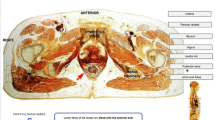Abstract
Introduction
Residency programs are demanding an increased understanding of cross-sectional anatomy from entering students. In response to a decrease in the curriculum hours being devoted to the study of anatomy and an increase in self-directed, computer-based learning, a Web-based cross-sectional learning tool (3D-X) was developed. The effectiveness of 3D-X was assessed.
Methodology
Undergraduate anatomy students (n=82) were randomly assigned to two groups. Group one spent the 50-minute learning session studying the structures of the abdomen from a prosection in the anatomy lab. Group two spent the first half of the lab session studying from a prosection in the anatomy lab and the second half in the computer lab using 3D-X.
Results
Students in group two scored significantly higher than their group one counterparts on both an identification-based CT posttest, and a one-month follow-up test. Qualitative analysis revealed that students found the tool useful when presented as an adjunct to traditional gross anatomy.
Conclusions
3D-X, when presented in addition to traditional gross anatomy, can improve students’ ability to identify anatomical structures in CT images, as well as improving anatomical knowledge of the abdomen.
Similar content being viewed by others
References
Turney BW. Anatomy in a modern medical curriculum. The Royal College of Surgeons of England 2007; 89: 104–107.
Cottam W. Adequacy of Medical School Gross Anatomy education as perceived by certain postgraduate residency programs and anatomy course directors. Clin Anat 1999; 12: 55–65.
Ketelsen D, Schrodl F, Knickenberg I, Heckermann R, Hothorn T, Neuhuber W, Werner B, Grunewald M. Modes of Information Delivery in Radiologic Anatomy Education: Impact on Student Performance. Acad Radiol 2007; 14: 93–99.
General Medical Council 2003. Tomorrow’s Doctors. Retrieved June 10, 2009. http://www.gmc-uk.org/education/undergraduate/GMC_tomorrows_doctors.pdf
Khalil MK, Lamar CH, Johnson TE. Using computer-based interactive imagery strategies for designing instructional anatomy programs. Clin Anat 2005; 18(1): 68–76.
Donnelly L, Patten D, White P, Finn G. Virtual human dissector as a learning tool for studying cross-sectional anatomy. Med Teach 2009; 1: 1–3.
Holt NF. Medical students need more radiology education. Acad Med 2001; 76: 1.
Barzansky B, Jonas HS, Etzel SI. Educational programs in U.S. medical schools. JAMA 1999; 282: 840–846.
Khalil MK, Paas F, Johnson TE, Su YK, Payer AF. Effects of Instructional Strategies Using Cross Sections on the Recognition of Anatomical Structures in Correlated CT and MR Images. Anat Sci Ed 2008; 1: 75–83.
Afaq A, McCall J. Improving Undergraduate Education in Radiology. Acad Radiol 2002; 9: 221–223.
Erkonen WE, Albanese MA, Smith WL, Pantazis NJ. Gross Anatomy Instruction with Diagnostic Images. Perspectives in Radiologic Education 1990; 25: 292–294.
Weidemann J, Hohn HP, Hiltner J, Tochtermann K, Tresp C, Bozinov D, Venjakob K, Freund A, Reusch B, Denker HW. A hypermedia tutorial for cross-sectional anatomy: HyperMed. Acta Anat (Basel) 1997;158(2): 133–42.
Jastrow H, Vollrath L. Teaching and Learning Gross Anatomy Using Modern Electronic Media Based on the Visible Human Project. Clin Anat 2003; 16: 44–54.
Barros N, Rodrigues CJ, Rodrigues AJ, Germano MA, Cerri G. The value of teaching sectional anatomy to improve CT scan interpretation. Clin Anat 2001; 14: 36–41.
Mitchell BS, Williams JE. Trends in Radiological Anatomy Teaching in the U.K. and Ireland. Clin Rad 2002; 57: 1070–1072.
Oh CS, Kim JY, Choe YH. Learning of Cross-sectional Anatomy Using Clay Models. Anat Sci Ed 2009; 2: 156–159.
Khalil MK, Payer A, Johnson TE. Effectiveness of Using Cross-sections in the recognition of anatomical structures in radiological images. The Anatomical Record 2005; 283B: 9–13.
Osirix 2007. Dicom Sample Image Sets. Retrieved June 10, 2009. http://pubimage.hcuge.ch:8080/
Canade A, Palladino F, Pitzallis G, Campioni P, Marano P. Web-based radiology: A future to be created. Rays 2003; 28(1): 109–17.
Khalil MK, Johnson TE, Lamar CH. Comparison of Computer-based and Paper-based Imagery strategies in learning Anatomy. Clin Anat 2005; 18(1): 457–464.
Pieters R S, Bogdasarian R, FitzGerald T J. An Interactive Anatomy Experience Utilizing a Computerized 3-Dimensional Radiation Oncology Planning and Treatment System. Med Sci Educ 2011; 21(1): 7
Drake R, McBribe J, and Lachman N. Medical education in the anatomical sciences: The winds of change continue to blow. Anat Sci Educ 2009; 2(6), 253–9.
Author information
Authors and Affiliations
Corresponding author
Rights and permissions
About this article
Cite this article
Dorosh, K., Bhattacharyya, S., Haase, P. et al. Effectiveness of a Dynamic Cross-Sectional Anatomy Learning Tool (3D-X) at Improving Students’ Ability to Interpret CT Images. Med.Sci.Educ. 23, 364–376 (2013). https://doi.org/10.1007/BF03341648
Published:
Issue Date:
DOI: https://doi.org/10.1007/BF03341648




